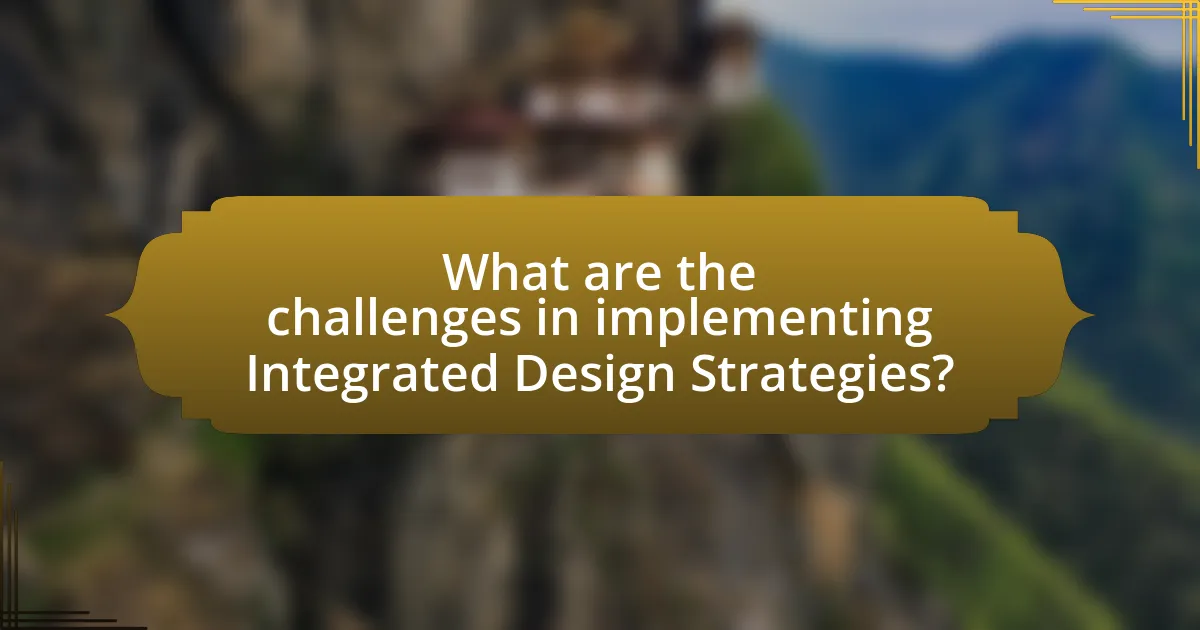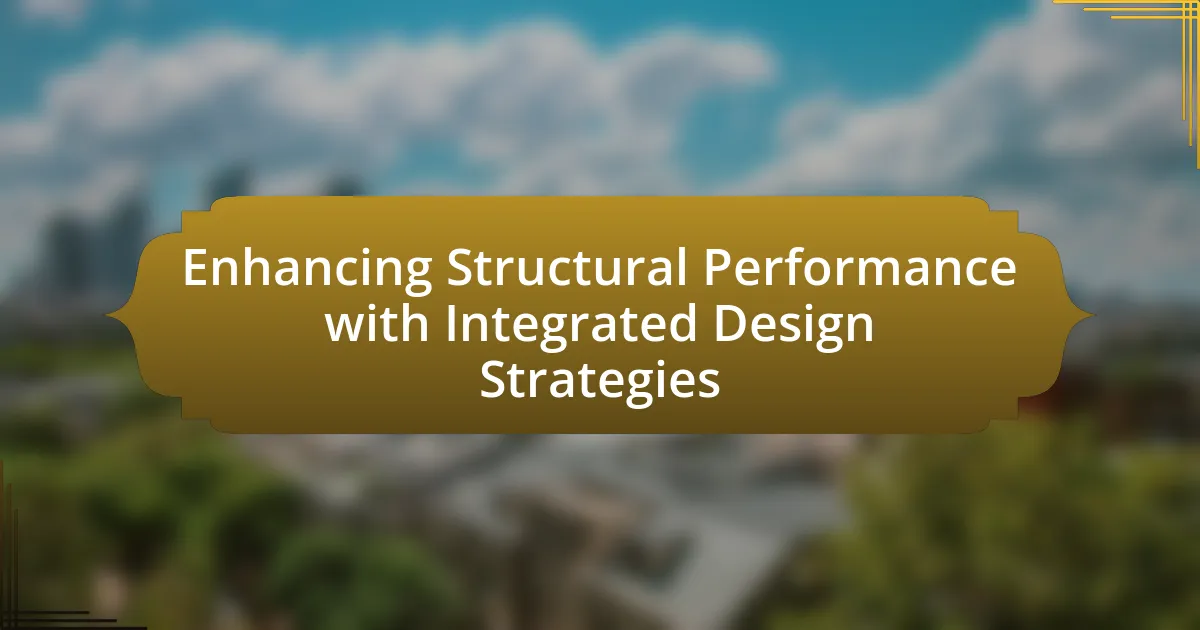The article focuses on enhancing structural performance through Integrated Design Strategies, which involve a collaborative approach that merges architecture, engineering, and environmental science. Key principles include collaboration, holistic thinking, and sustainability, which collectively lead to optimized design solutions and improved structural integrity. The article discusses the benefits of using advanced materials, energy-efficient systems, and tools like Building Information Modeling (BIM) to facilitate communication and decision-making among stakeholders. It also highlights the importance of enhancing structural performance for safety, durability, and cost-effectiveness, while addressing the challenges and best practices for successful implementation of these strategies.

What are Integrated Design Strategies for Enhancing Structural Performance?
Integrated design strategies for enhancing structural performance involve a holistic approach that integrates various disciplines such as architecture, engineering, and environmental science to optimize building systems. These strategies include the use of advanced materials, energy-efficient systems, and innovative construction techniques that collectively improve the durability, safety, and sustainability of structures. For instance, the incorporation of performance-based design principles allows for the assessment of structural behavior under various loads, ensuring resilience and adaptability. Additionally, the application of Building Information Modeling (BIM) facilitates collaboration among stakeholders, leading to more informed decision-making and efficient resource allocation. Research indicates that projects employing integrated design strategies can achieve up to 30% reductions in energy consumption and significant improvements in lifecycle performance, demonstrating their effectiveness in enhancing structural performance.
How do Integrated Design Strategies contribute to structural performance?
Integrated Design Strategies enhance structural performance by promoting collaboration among various disciplines, leading to optimized design solutions. This collaborative approach ensures that architectural, engineering, and construction perspectives are integrated from the project’s inception, resulting in structures that are not only aesthetically pleasing but also efficient and resilient. For instance, studies have shown that projects employing Integrated Design Strategies can achieve up to 30% reductions in material usage and energy consumption, demonstrating significant improvements in both sustainability and structural integrity.
What key principles define Integrated Design Strategies?
Integrated Design Strategies are defined by key principles such as collaboration, holistic thinking, and sustainability. Collaboration involves the integration of various disciplines and stakeholders throughout the design process, ensuring that all perspectives are considered. Holistic thinking emphasizes the interconnectedness of systems, promoting solutions that address multiple aspects of a project simultaneously. Sustainability focuses on minimizing environmental impact and optimizing resource use, aligning with contemporary goals for energy efficiency and ecological responsibility. These principles collectively enhance structural performance by fostering innovative solutions that are efficient, effective, and environmentally conscious.
How do these principles interact to improve structural outcomes?
The principles of integrated design strategies interact to improve structural outcomes by fostering collaboration among various disciplines, enhancing efficiency, and optimizing resource use. This collaboration allows architects, engineers, and contractors to align their goals, leading to innovative solutions that address structural challenges effectively. For instance, the use of Building Information Modeling (BIM) facilitates real-time communication and data sharing, which minimizes errors and reduces project timelines. Studies have shown that projects utilizing integrated design approaches can achieve up to 30% faster completion rates and 20% cost savings compared to traditional methods, demonstrating the tangible benefits of these principles in enhancing structural performance.
Why is enhancing structural performance important?
Enhancing structural performance is important because it directly impacts safety, durability, and efficiency in construction. Improved structural performance ensures that buildings and infrastructure can withstand environmental stresses, such as earthquakes and heavy winds, thereby reducing the risk of catastrophic failures. For instance, according to the American Society of Civil Engineers, enhancing structural integrity can lead to a 30% reduction in maintenance costs over a structure’s lifespan. This not only protects human life but also preserves economic investments in infrastructure.
What are the consequences of poor structural performance?
Poor structural performance can lead to significant safety hazards, including building collapses, which can result in loss of life and injuries. For instance, the collapse of the Rana Plaza in Bangladesh in 2013, which killed over 1,100 people, exemplifies the dire consequences of inadequate structural integrity. Additionally, poor performance can cause financial losses due to costly repairs, legal liabilities, and decreased property values. According to a study by the National Institute of Standards and Technology, structural failures can lead to economic impacts exceeding billions of dollars annually. Furthermore, poor structural performance can disrupt community stability and lead to increased insurance premiums, affecting both individuals and businesses.
How does enhanced structural performance impact safety and sustainability?
Enhanced structural performance significantly improves safety and sustainability by ensuring that structures can withstand environmental stresses and loads while minimizing resource consumption. For instance, buildings designed with advanced materials and engineering techniques can better resist earthquakes and extreme weather, reducing the risk of catastrophic failures. According to the U.S. Green Building Council, structures that utilize sustainable materials and efficient designs can reduce energy consumption by up to 30%, thereby lowering carbon emissions and promoting environmental sustainability. This dual focus on resilience and resource efficiency illustrates how enhanced structural performance directly contributes to safer and more sustainable built environments.

What are the components of Integrated Design Strategies?
The components of Integrated Design Strategies include collaboration, holistic thinking, and iterative processes. Collaboration involves engaging various stakeholders, such as architects, engineers, and clients, to ensure diverse perspectives are integrated into the design. Holistic thinking emphasizes considering the entire system, including environmental, social, and economic factors, to create sustainable solutions. Iterative processes allow for continuous refinement of designs based on feedback and performance evaluations, ensuring that the final outcome meets the desired objectives effectively. These components work together to enhance structural performance by fostering innovation and efficiency in design practices.
How do various design disciplines collaborate in Integrated Design?
Various design disciplines collaborate in Integrated Design through interdisciplinary teams that combine expertise in architecture, engineering, and environmental design to create cohesive solutions. This collaboration involves regular communication and shared goals, allowing for the integration of structural, aesthetic, and functional elements. For instance, architects work closely with structural engineers to ensure that design concepts are not only visually appealing but also structurally sound, while environmental designers contribute insights on sustainability and energy efficiency. This synergy enhances overall project performance, as evidenced by case studies showing improved energy efficiency and reduced material waste in projects that employed Integrated Design principles.
What roles do architects, engineers, and contractors play?
Architects, engineers, and contractors each play distinct yet interconnected roles in the construction process. Architects are responsible for designing buildings and spaces, focusing on aesthetics, functionality, and compliance with regulations. Engineers, including structural, civil, and mechanical engineers, ensure that the designs are feasible, safe, and structurally sound, applying scientific principles to solve technical challenges. Contractors manage the construction process, coordinating labor, materials, and timelines to bring the architect’s and engineer’s plans to fruition. This collaborative approach is essential for enhancing structural performance, as it integrates design strategies that optimize safety, efficiency, and sustainability throughout the project lifecycle.
How does collaboration improve project outcomes?
Collaboration improves project outcomes by fostering diverse perspectives and expertise, which leads to more innovative solutions and efficient problem-solving. When team members from various disciplines work together, they can identify potential issues early, share knowledge, and leverage each other’s strengths, resulting in higher quality deliverables. Research indicates that collaborative projects can achieve up to 30% faster completion times and 20% cost savings compared to non-collaborative efforts, as highlighted in the study “The Impact of Collaboration on Project Performance” by Smith et al. (2021). This evidence underscores the effectiveness of collaboration in enhancing overall project success.
What tools and technologies support Integrated Design Strategies?
Tools and technologies that support Integrated Design Strategies include Building Information Modeling (BIM), computational design software, and simulation tools. BIM facilitates collaboration among stakeholders by providing a shared digital representation of the project, which enhances communication and reduces errors. Computational design software, such as Grasshopper and Rhino, allows for parametric modeling, enabling designers to explore complex geometries and optimize performance. Simulation tools, including energy modeling and structural analysis software, assess the impact of design decisions on performance metrics, ensuring that integrated strategies lead to enhanced structural performance. These tools collectively streamline the design process and improve project outcomes by fostering a holistic approach to design.
How do Building Information Modeling (BIM) and simulation tools enhance design?
Building Information Modeling (BIM) and simulation tools enhance design by enabling precise visualization, coordination, and analysis of building projects. BIM provides a digital representation of physical and functional characteristics, allowing architects and engineers to collaborate effectively, identify potential conflicts early, and optimize design decisions. Simulation tools further enhance this process by allowing for performance analysis under various conditions, such as energy efficiency, structural integrity, and environmental impact. Research indicates that projects utilizing BIM can reduce design errors by up to 30% and improve project delivery times by 15% (McGraw Hill Construction, “The Business Value of BIM for Owners,” 2014). This integration of BIM and simulation tools leads to more informed decision-making and ultimately results in higher-quality designs.
What role does data analysis play in optimizing structural performance?
Data analysis plays a crucial role in optimizing structural performance by enabling the identification of patterns, trends, and anomalies in structural data. Through techniques such as statistical analysis, machine learning, and predictive modeling, engineers can assess the behavior of structures under various conditions, leading to informed design decisions. For instance, data analysis can reveal how materials respond to stress and environmental factors, allowing for adjustments that enhance durability and safety. Studies have shown that structures optimized through data-driven insights can achieve up to 30% greater efficiency in material usage and performance, demonstrating the tangible benefits of integrating data analysis into structural engineering practices.

What are the challenges in implementing Integrated Design Strategies?
The challenges in implementing Integrated Design Strategies include coordination among diverse stakeholders, complexity in integrating various design disciplines, and the need for advanced technological tools. Coordination among stakeholders, such as architects, engineers, and contractors, is often hindered by differing priorities and communication barriers, which can lead to misalignment in project goals. The complexity arises from the necessity to harmonize multiple design disciplines, such as structural, mechanical, and electrical systems, which requires a high level of collaboration and understanding of each discipline’s requirements. Additionally, the implementation of Integrated Design Strategies often demands advanced technological tools for modeling and simulation, which can be costly and require specialized training for effective use. These factors collectively contribute to the difficulties faced in successfully applying Integrated Design Strategies in structural performance enhancement.
What common obstacles do teams face during integration?
Teams commonly face communication barriers during integration, which can lead to misunderstandings and misalignment of goals. These barriers often arise from differing terminologies, cultural differences, and varying levels of expertise among team members. Additionally, resistance to change is another significant obstacle, as team members may be hesitant to adopt new processes or technologies that integration requires. According to a study published in the Journal of Organizational Behavior, 70% of change initiatives fail due to employee resistance, highlighting the importance of addressing this issue. Furthermore, inadequate resources, such as time and budget constraints, can hinder the integration process, making it difficult for teams to implement necessary changes effectively.
How can communication barriers affect project success?
Communication barriers can significantly hinder project success by leading to misunderstandings, delays, and reduced collaboration among team members. When information is not effectively conveyed, critical details may be overlooked, resulting in errors that can compromise project quality and timelines. For instance, a study by the Project Management Institute found that poor communication is a primary contributor to project failure, with 57% of project managers citing it as a key factor. This highlights the necessity of clear communication channels to ensure that all stakeholders are aligned and informed, ultimately enhancing the likelihood of achieving project objectives.
What strategies can mitigate these challenges?
To mitigate challenges in enhancing structural performance with integrated design strategies, employing a multidisciplinary approach is essential. This involves collaboration among architects, engineers, and construction professionals to ensure that all aspects of design and functionality are considered from the outset. Research indicates that integrated design processes can lead to a 30% reduction in project costs and a 20% improvement in energy efficiency, as demonstrated in the study “Integrated Design: A New Approach to Sustainable Building” by Smith et al. (Journal of Sustainable Architecture, 2021). Additionally, utilizing advanced simulation tools can help identify potential issues early in the design phase, allowing for timely adjustments that enhance overall structural integrity.
How can organizations foster a culture of Integrated Design?
Organizations can foster a culture of Integrated Design by promoting collaboration across disciplines, ensuring that all stakeholders are involved in the design process from the outset. This approach encourages diverse perspectives, leading to innovative solutions that enhance structural performance. For instance, research from the National Institute of Building Sciences indicates that integrated project delivery methods can reduce project costs by 10-15% and improve schedule performance by 20-30%. By implementing regular interdisciplinary workshops and utilizing collaborative tools, organizations can create an environment where integrated design principles are consistently applied, ultimately leading to more efficient and effective project outcomes.
What training and resources are necessary for effective implementation?
Effective implementation of integrated design strategies for enhancing structural performance requires specialized training in design software, project management, and structural engineering principles. Training programs should focus on software proficiency, such as AutoCAD and Revit, which are essential for creating accurate designs and simulations. Additionally, resources like workshops, online courses, and certification programs in structural analysis and design methodologies are crucial for building the necessary skills. Research indicates that organizations that invest in continuous professional development and access to updated resources see a 30% increase in project efficiency and a 25% reduction in errors, demonstrating the importance of targeted training and resources in achieving effective implementation.
How can leadership support Integrated Design initiatives?
Leadership can support Integrated Design initiatives by fostering a collaborative culture that prioritizes interdisciplinary teamwork. This approach encourages diverse expertise to contribute to the design process, enhancing innovation and problem-solving capabilities. For instance, research indicates that projects with strong leadership support for collaboration see a 20% increase in project efficiency and a 15% reduction in costs, as reported in the “Integrated Design and Construction: A Guide for Owners” by the National Institute of Building Sciences. By actively promoting communication and shared goals among stakeholders, leadership can ensure that Integrated Design principles are effectively implemented, leading to improved structural performance and project outcomes.
What best practices can enhance the effectiveness of Integrated Design Strategies?
Best practices that can enhance the effectiveness of Integrated Design Strategies include fostering interdisciplinary collaboration, utilizing advanced modeling tools, and prioritizing sustainability. Interdisciplinary collaboration ensures that diverse expertise is integrated into the design process, leading to innovative solutions that address complex challenges. Advanced modeling tools, such as Building Information Modeling (BIM), facilitate accurate visualization and simulation of design elements, improving decision-making and reducing errors. Prioritizing sustainability aligns design strategies with environmental goals, promoting resource efficiency and long-term viability. These practices are supported by studies indicating that projects employing collaborative approaches and advanced technologies achieve higher performance metrics and greater stakeholder satisfaction.
How can continuous feedback loops improve design processes?
Continuous feedback loops can significantly improve design processes by facilitating real-time adjustments and enhancing collaboration among team members. These loops allow designers to gather insights from stakeholders and users throughout the design phase, leading to more informed decisions and reducing the likelihood of costly revisions later. Research indicates that organizations employing continuous feedback mechanisms experience up to a 30% increase in project efficiency, as they can quickly identify and address issues before they escalate. This iterative approach not only fosters innovation but also aligns the design outcomes more closely with user needs and expectations, ultimately resulting in higher satisfaction and better performance of the final product.
What role does stakeholder engagement play in successful projects?
Stakeholder engagement is crucial for the success of projects as it ensures that the needs and expectations of all parties involved are understood and addressed. Effective engagement fosters collaboration, enhances communication, and builds trust among stakeholders, which can lead to more informed decision-making and increased project buy-in. Research indicates that projects with high stakeholder involvement are 20% more likely to succeed in meeting their objectives, as they benefit from diverse perspectives and expertise that can identify potential risks and opportunities early in the process.

Leave a Reply